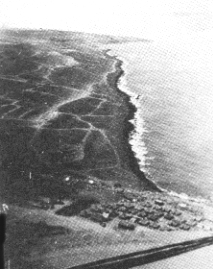|
|
|
Fifth
Marine Cemetery - Iwo Jima
|
Iwo
Jima - An Island of Cemeteries
On
27 May, our crew (P-5) was ordered to Iwo Jima for a period
of DS (Detached Service). The purpose of the assignment was
two-fold: to participate in search missions for downed B-29
airmen along the Japanese coast; and to serve as navigational
escort for P-51's in a forthcoming strike against the seaport
of Yokohama. These 1500-mile round trip flights for the P-51's
would be the longest in fighter aircraft history.
As
we peered down the tiny five and one-half mile long island,
certain features stood out conspicuously. The over all view
of pork-chop shaped Iwo was one of ugliness and desolation;
it's black volcanic ash much like the surface of the moon. Rising
556-feet at its southern tip stood historic Mount Suribachi,
an inactive volcano. It was here that the valiant Fifth Marine
Division had bitterly fought its way to the top. In perhaps
the most memorable scene of World War II, they planted the American
Flag on the brim of its deep crater.
Highly
visible, too, were the island's three air
fields situated atop a flat ridge and simply known as Motoyama
# 1, # 2, # 3.
The
most inspiring sight of all, though were Iwo's three cemeteries,
each with its long symmetrical rows of white crosses. They stood
in stark contrast against the island's black sandy background
- the final resting places for over 6,800 Americans lost in
the struggle for Iwo. Add to this about 19,000 injured, and
it ranked as one of the bloodiest of all battles in American
History. Out of an estimated 21,000 Japanese troops, only 1000
had been taken prisoner. The others died in combat, were incinerated
or sealed in caves, or chose to die by committing suicide.
| |
| Iwo
Jima Right Shore Line
Looking from Mt. Suribachi |
There
were 353 Congressional Medals of Honor bestowed during the fours
of World War II, both in Europe and the Pacific. Of this number
27 of them went to veterans of Iwo in an operation lasting just
over a month. Iwo Jima was taken solely to provide sanctuary
for battle damaged and fuel short B-29's returning from Japan.
Located halfway between the Marianas and Tokyo, it would substantially
reduce the many hazardous, even life-taking, ditches at sea.
Though
the island's cost in lives had been horrendous, its value to
the B-29 crew became increasingly obvious. The first landing
of a B-29 on Iwo Jima occurred on 4 March 1945. It was the "Dinah
Might," piloted by Captain Raymond Malo. From this day forward,
the significance of Iwo's acquisition could never be questioned.
It's safe to say that nearly every Superfort sought refuge there
at least once in an emergency situation. As result, countless
crews and airmen survived to fly another day. Of further importance,
long-range American fighters were now able to strike Japan -
only 750 miles away. Moreover, it also made it possible to provide
much needed fighter escort protection for B-29s.
Unquestionably,
this tiny obscure and God forsaken dot of volcanic residue became
the most important life and plane saver for the 21st Bomber
Command - one that altered dramatically the direction and conduct
of the Pacific air war.
|





